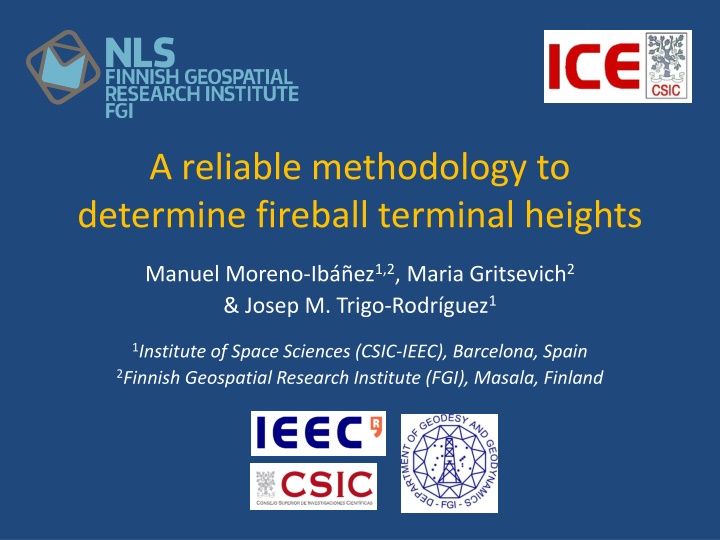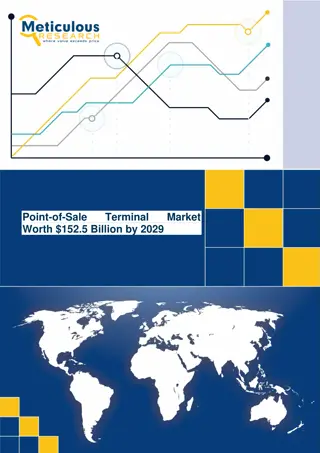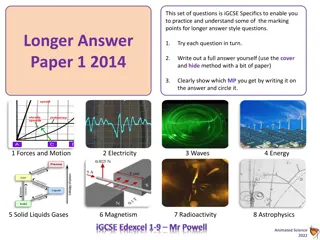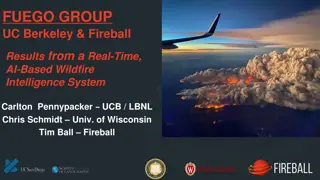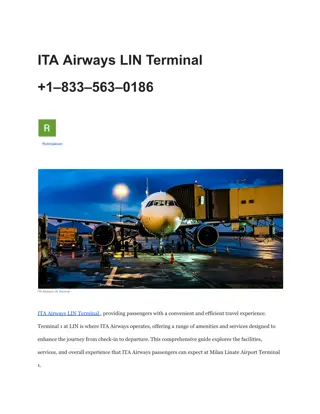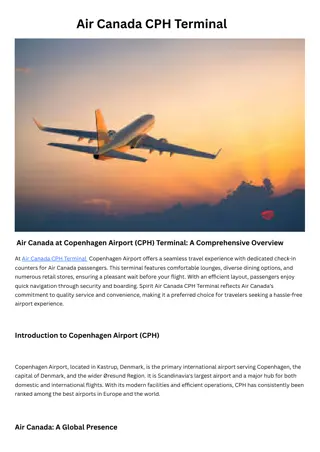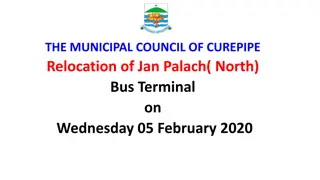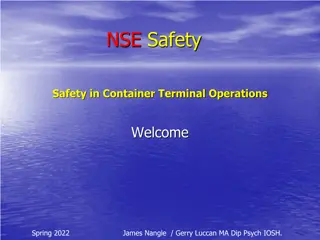A reliable methodology to determine fireball terminal heights
Fireball terminal heights can be accurately determined using scaling laws, dimensionless variables, equations of motion, and analytical solutions. This methodology gathers unknown values into key variables for precise calculations. The study delves into distinguishing meteoroid types and empirical criteria based on observational parameters.
Download Presentation

Please find below an Image/Link to download the presentation.
The content on the website is provided AS IS for your information and personal use only. It may not be sold, licensed, or shared on other websites without obtaining consent from the author.If you encounter any issues during the download, it is possible that the publisher has removed the file from their server.
You are allowed to download the files provided on this website for personal or commercial use, subject to the condition that they are used lawfully. All files are the property of their respective owners.
The content on the website is provided AS IS for your information and personal use only. It may not be sold, licensed, or shared on other websites without obtaining consent from the author.
E N D
Presentation Transcript
A reliable methodology to determine fireball terminal heights Manuel Moreno-Ib ez1,2, Maria Gritsevich2 & Josep M. Trigo-Rodr guez1 1Institute of Space Sciences (CSIC-IEEC), Barcelona, Spain 2Finnish Geospatial Research Institute (FGI), Masala, Finland
Scaling laws and dimensionless variables: Equations of motion The equations of motion for a meteoroid entering the atmosphere projected onto the tangent and to the normal to the trajectory 1 Drag force 1 dV = + 2 sin M c V a S P d 2 dt Variation of the mass Lifting force 2 dt 2 1 d MV 1 dM = 2 cos cos MV P c V a S = * 3 H c V a S L 2 R h 2 dt dh = sin V dt 3 Extra equations ( ) = exp / Isothermal atmosphere h h 0 = 1956 ( ) / ( / ) Levin S S M M e e = = = = = 0 ; ; ; 0; y h 4 M M m V V v S S s h Use of dimensionless parameters e e e a Where index e indicates values at the entry of the atmosphere. h0 is the scale height (7.16 km) 2 (See: Stulov et al.,1995; Stulov, 1997; and Gritsevich, 2007)
Scaling laws and dimensionless variables: final equations ( 1 ) 2 1 v = exp ] 1 [ m : Analytical solution of system = = = : ; ; 1 1 Initial conditions y v m = + = 2 ln 2 ln , ( ) ( ) ] 2 [ y Ei Ei v z e dz x = ( ) Ei x z In this methodology we gather all the unknown values of the meteoroid s atmosphere flight motion equations into two new variables (Gritsevich, 2009): BallisticCoefficient Mass loss parameter 1 h S 2 c V h ( ) = c = 0 0 e 1 e dM * 2 sin 2 c H d e Already tested in: Gritsevich, 2008; Gritsevich, 2009; Gritsevich and Koschny, 2011; Bouquet et al., 2014; and Moreno-Ib ez et al., 2015. 3
Introduction: terminal heights in the literature. Definition: it is the point during the meteoroid atmospheric flight where its kinetic energy is no longer sufficient to produce luminosity. Ceplecha and McCrosky (1976) Wetherill and Revelle (1981) Focus : to distinguish between ordinary and carbonaceous chondrites within the PN. Focus: to find ordinary chondrites within the PN data. The end height as the principal discriminating observational parameter in their discussion (photometric mass). Criterion: any ordinary chondrite shall show similar flight properties that the Lost City ordinary chondrite meteorite. Empirical criterion based on the terminal height (dynamic): + + = They used four criteria: agreement of the observed and theoretical single-body end heights (using dynamic mass). + log log log log(cos ) PE A m B V C Z E R Second criterion based on fireball physics: Similar results than Ceplecha and McCrosky (1976). = log + log SD K Both criteria are complementary. 4
Simplifications of the exact solution I For quick meteors, a strong evaporation process takes place so becomes high ( >> 1), the deceleration can be neglected and the velocity thus assumed constant. Stulov (1998, 2004) developed the following asymptotic solution: = = y , 1 1 2 , ln 2 ] 3 [ v e y = = ln 2 ] 5 [ h h y h 0 0 I t II However, the meteor velocity begins to decrease in a certain vicinity of m=0. In order to account for this change in velocity we combine the Eq.[1] (valid for arbitrary values) with the Eq. [3] suitable for high values: ( 1 ) 1 y 2 ln 2 e = + 1 , ln 2 ] 4 [ v y 2 e = = ln ] 6 [ h h y h ( ) 0 0 II t 2 1 tv 1 5
We compare our derived terminal heights with the fireball terminal heights registered by the Meteorite Observation and Recovery Project operated in Canada between 1970 and 1985 (MORP) (Halliday et al. 1996). We use previous and values derived by Gritsevich (2009). 2 e = = ) ln h h y h = = 2 ln h h y h ( 0 0 II t 2 1 tv 1 0 0 I t = . 4 11 Km . 1 = 52 Km 6
Improvement using approximated functions Problem: terminal height hII shows certain discrepancies at low values. Solution: we suggest to improve the performance of the simplification adopted compared to the analytical solution of the problem. vs. 1 ln ( ) 1 y 2 2 e = + ln 2 ln y = + 1 v We use the mathematical analysis carried out in Gritsevich et al. (2016), which considers the possibility of including an approximation function which slightly modified this equation. 1 . 1 ( ( ) 1 1 . 1 2 = = ln ] 7 [ h h y h )( ) 0 0 III t 2 1 . 1 tv 1 e This approximation function is thought to improve accuracy in those cases where > 3, which is not completely our current scenario. We want to improve accuracy for those cases with moderated values showing low terminal heights. 7
= = 2 ln h h y h ( ( ) 1 0 0 I t 2 1 . 1 = = ) ln h h y h )( 0 0 III t 2 1 . 1 tv 1 e = . 4 11 Km 2 e = = ) ln h h y h ( 0 0 II t 2 1 tv 1 = . 0 75 Km . 1 = 52 Km 8
Future Work Atmospheric correction: Height (Km) 65 the amount of air that a fireball encounters depends on the atmosphere conditions. Thus, it should be considered particularly for large mass, slow, low penetrating fireballs which usually indicate meteorite-droppers. (see Lyytinen and Gritsevich, 2016 ) H_Observed H_ISA 55 H_Weather Station Annama (2014) 45 35 Meteor observation: 25 we foresee a calculation of terminal height to be useful when the lower part of the trajectory is not instrumentally registered. Velocity (Km/s) 15 12 17 22 27 New types of studies to be scoped: Analysis of the inverse problem: Meteor height as a function of time: - Determination of luminous efficiency based on meteor duration. - Critical Kinetic Energy to produce luminosity. possible for non decelerated bodies if the terminal height is known constraints in and . ln hI= 2 0h 9
Conclusions We have accurately derived the terminal heights for MORP fireballs using a new developed methodology based on scaling laws and dimensionless variables. This methodology had only been tested on several fully ablated fireballs with large values (Gritsevich and Popelnskaya, 2008). Now, we have proved it works equally for fully ablated fireballs and meteorite-producing ones. The study of terminal height of large FN datasets could provide interesting knowledge about the recorded fireballs (e.g. works by Ceplecha and McCrosky, 1976; and Wetherill and Revelle, 1981), or show unexpected inaccuracies in the FN recordings. Future work could scope new research based on terminal height analysis. E.g. we can highly recommend the use of equation [7] also to solve inverse problem when heights and velocities are available from the observations, and parameters and need to be derived. 10
References M. Moreno-Ib ez, et al., Icarus 250, 544-552 (2015). mmoreno@ice.csic.es, gritsevich@list.ru , trigo@ice.csic.es, Z. Ceplecha and R.E. McCrosky, J.Geophys. Res. 81, 6257-6275 (1976). A. Bouquet et al. Planetary Space Science 103:238-249 (2014). M. Gritsevich, Solar Syst. Res. 41 (6), 509-514 (2007). M. Gritsevich, Solar Syst. Res. 42, 372-390 (2008). M. Gritsevich and N.V. Popelenskaya, Doklady Phys. 53, 88-92 (2008). M. Gritsevich, Adv. Space Res. 44. 323-334 (2009). M. Gritsevich, and D. Koschny, Icarus 212 (2), 877-884 (2011). M. Gritsevich et al., Mat. Model. Comp. Simul. 8 (1) 1-6 (2016). I. Halliday et al., Meteorit. Planet. Sci. 31, 185-217 (1996). E. Lyytinen and M. Gritsevich, Planet. Space Sci. 120, 35-42(2016). V.P. Stulov et al., Aerodinamika bolidov, Nauka (1995). V.P. Stulov, Appl. Mech. Rev. 50, 671-688 (1997). V.P. Stulov, Planet. Space Sci. 46, 253-260 (1998). V.P. Stulov, Planet. Space Sci. 52 (56), 459-463 (2004). G.W. Wetherill and D.O. Revelle, Icarus 48, 308-328 (1981). F. L. Whipple and L. Jacchia , Smithson. Contrib. Astrophys. 1, 183 206 (1957) 11
